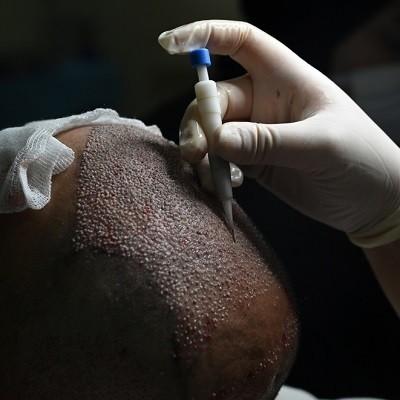Are There Any Side Effects of Hair Transplant Procedures in Islamabad?

Hair transplant procedures have become a widely sought-after solution for individuals suffering from hair loss. Whether due to genetics, stress, or other factors, hair loss can have a significant impact on a person’s self-esteem and quality of life. As such, many people in Islamabad and around the world have turned to hair transplants to regain their confidence and restore their natural hairline. While the procedure has gained popularity for its effectiveness, it is important to understand that like any medical procedure, hair transplants can come with certain side effects. In this blog, we will explore the potential side effects of hair transplant in Islamabad, so you can make an informed decision about your treatment.
1. Swelling and Redness
One of the most common side effects of a hair transplant is swelling, especially in the forehead and around the eyes. This occurs due to the trauma caused by the surgery and the insertion of hair follicles into the scalp. Swelling typically peaks within the first two days after the procedure and then begins to subside gradually. It is not unusual for patients to experience some redness in the donor and recipient areas as well. This is also a result of the minor surgical incisions made during the hair transplant process.
In most cases, swelling and redness are temporary and will resolve within a few days to weeks. To manage these effects, patients are often prescribed anti-inflammatory medications and advised to apply cold compresses.
2. Scabbing and Crusting
Scabs or crusts can form in both the donor and recipient areas following a hair transplant. This is a normal part of the healing process. When hair follicles are transplanted into the scalp, tiny incisions are made in the skin, which can cause some minor bleeding. As the blood dries, scabs form to protect the newly implanted hair follicles. The scabs can last anywhere from a few days to a week.
It is crucial to avoid picking or scratching the scabs, as this could lead to infection or cause hair follicles to be dislodged prematurely. Following the aftercare instructions provided by your surgeon will help minimize scabbing and ensure proper healing.
3. Temporary Hair Shedding (Shock Loss)
A phenomenon called “shock loss” is a temporary shedding of hair that can occur after a hair transplant. This is quite common and usually happens within the first few weeks after the procedure. Shock loss happens when the transplanted hair follicles enter a resting phase and shed the hair strands that were implanted. It is important to note that this shedding is temporary, and the hair follicles will start growing new hair after a few months.
The shedding can be distressing, but it is essential to understand that it is part of the natural hair growth cycle. Most patients experience new hair growth within 3 to 6 months after the transplant, with full results typically visible in 9 to 12 months.
4. Infection and Scalp Infections
Though rare, infection is one of the more serious side effects that can occur after a hair transplant. The risk of infection increases if post-surgical care is not followed properly, such as keeping the scalp clean or avoiding touching the treated area with dirty hands. Scalp infections can lead to pain, redness, swelling, and, in some cases, loss of the transplanted hair follicles.
To reduce the risk of infection, patients are advised to follow their surgeon’s instructions closely, which may include taking antibiotics, using antiseptic solutions, and avoiding direct sun exposure for the first few weeks. Ensuring the clinic you choose in Islamabad maintains high standards of hygiene and safety will also help minimize infection risks.
5. Numbness or Tingling Sensation
Many patients report experiencing a numb or tingling sensation in the donor or recipient area after a hair transplant. This sensation is caused by the disruption of nerves during the procedure. The numbness is typically temporary and will gradually disappear over time, usually within a few weeks to months.
If the numbness persists for an extended period or is accompanied by severe pain, it is important to consult your surgeon for further evaluation.
6. Unnatural or Uneven Hair Growth
While hair transplants are generally highly successful, there are instances where the transplanted hair may not grow as expected. This could result in uneven hair growth, which may require additional procedures or touch-ups. In some cases, the angle or direction of hair growth may appear unnatural, particularly if the surgeon’s technique was not ideal.
To avoid such issues, it is critical to choose an experienced and qualified surgeon in Islamabad who uses advanced techniques such as FUE (Follicular Unit Extraction) or FUT (Follicular Unit Transplantation). An expert surgeon will ensure the proper placement and direction of hair follicles for the most natural-looking results.
7. Scarring
Although the risk of scarring is minimal with modern techniques like FUE, there is still the possibility of scarring with a hair transplant. FUT, for example, involves removing a strip of skin from the donor area, which may leave a linear scar along the back of the scalp. However, this scar is typically well-hidden by surrounding hair.
FUE, on the other hand, involves harvesting individual follicles and results in small, dot-like scars that are less noticeable. It is essential to follow post-operative care instructions to minimize scarring and promote proper healing.
Conclusion
While hair transplant procedures in Islamabad are generally safe and effective, they do come with certain side effects, as outlined above. Most of these side effects are temporary and can be managed with proper aftercare. It is essential to follow your surgeon’s instructions carefully, avoid unnecessary stress, and remain patient as your hair goes through the healing and growth process. If you experience any concerning or persistent side effects, be sure to contact your surgeon immediately for guidance.



